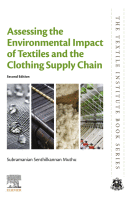Browse content
Table of contents
Actions for selected chapters
- Full text access
- Book chapterAbstract only
1 - Introduction to sustainability and the textile supply chain and its environmental impact
Pages 1-32 - Book chapterAbstract only
2 - Ways of measuring the environmental impact of textile processing: An overview
Pages 33-56 - Book chapterAbstract only
3 - Textile processing and greenhouse gas emissions: Methods for calculating the product carbon footprint of textile products
Pages 57-75 - Book chapterAbstract only
4 - Calculating the water and energy footprints of textile products
Pages 77-93 - Book chapterAbstract only
5 - Textile processing and resource depletion: Calculating the ecological footprint of textile products
Pages 95-103 - Book chapterAbstract only
6 - Estimating the overall environmental impact of textile processing: Life cycle assessment of textile products
Pages 105-129 - Book chapterAbstract only
7 - Life cycle assessment and product carbon footprint modelling of textile products
Pages 131-141 - Book chapterAbstract only
8 - End-of-life management of textile products
Pages 143-160 - Book chapterAbstract only
9 - Measuring the environmental impact of textiles in practice: Calculating the product carbon footprint and life cycle assessment of particular textile products
Pages 161-179 - Book chapterAbstract only
10 - Assessing the environmental impact of textiles: Summary and conclusions
Pages 181-186 - Book chapterNo access
Index
Pages 187-196
About the book
Description
Assessing the Environmental Impact of Textiles and the Clothing Supply Chain, Second Edition, is a fully updated, practical guide on how to identify and respond to environmental challenges across the supply chain. This new edition features updates to important data on environmental impacts and their measurements, the sustainable use of water and electricity, and new legislation, standards and schemes. Chapters provide an introduction to the textile supply chain and an overview of the methods used to measure environmental impacts, including greenhouse gas emissions, water and energy footprints, and a lifecycle assessment (LCA) on environmental impacts.
This book will be a standard reference for R&D managers in the textile industry and academic researchers in textile science.
Assessing the Environmental Impact of Textiles and the Clothing Supply Chain, Second Edition, is a fully updated, practical guide on how to identify and respond to environmental challenges across the supply chain. This new edition features updates to important data on environmental impacts and their measurements, the sustainable use of water and electricity, and new legislation, standards and schemes. Chapters provide an introduction to the textile supply chain and an overview of the methods used to measure environmental impacts, including greenhouse gas emissions, water and energy footprints, and a lifecycle assessment (LCA) on environmental impacts.
This book will be a standard reference for R&D managers in the textile industry and academic researchers in textile science.
Key Features
- Provides a holistic view of the sustainability issues that affect the textile value chain
- Explains ways to calculate the textile industry’s use of resources, its impact on global warming, and the pollution and waste it generates
- Reviews key methods for the reduction of the environmental impact of textile products and how they are implemented in practice
- Includes methods for calculating product carbon footprints (PCFs), ecological footprints (EFs) and lifecycle assessments (LCA)
- Provides a holistic view of the sustainability issues that affect the textile value chain
- Explains ways to calculate the textile industry’s use of resources, its impact on global warming, and the pollution and waste it generates
- Reviews key methods for the reduction of the environmental impact of textile products and how they are implemented in practice
- Includes methods for calculating product carbon footprints (PCFs), ecological footprints (EFs) and lifecycle assessments (LCA)
Details
ISBN
978-0-12-819783-7
Language
English
Published
2020
Copyright
Copyright © 2020 Elsevier Ltd. All rights reserved.
Imprint
Woodhead Publishing
